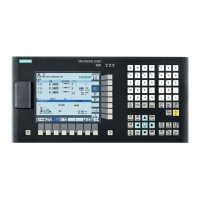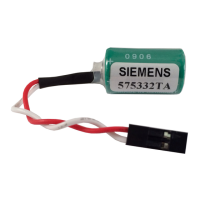Bit 8 = 0:
Absolute encoders can only be readjusted in the enabled state MD34210
$MA_ENC_REFP_STATE = 1.
Bit 8 = 1:
Absolute encoders can also be readjusted in the adjusted state MD34210
$MA_ENC_REFP_STATE = 2.
Bit 9 = 0:
Coupled axes (e.g. gantry) jointly delete their pulse enable if an error occurs.
Bit 9 = 1:
Coupled axes (e.g. gantry) only delete their pulse enable for their own errors.
Bit 10 = 0:
The maximum dynamic performance of a TRAIL or TANGON axis limits the maximum dynamic
path response.
Bit 10 = 1:
The maximum dynamic performance of a TRAIL or TANGON axis has no effect on the dynamic
path response. This can result in a longer overtravel of the dependent axis.
Bit 11 = 0:
Deactivation of the CP software limit monitoring
Bit 11 = 1:
Activation of the CP software limit monitoring for the following slave axes/spindles:
- coupling, type CP with CPSETTYPE[FAx] = "CP"
- coupling, type CP, TRAIL, EG, LEAD, or COUP with a maximum of one active master axis/
spindle
Bit 12 = 0:
When resetting the control enable of the stationary axis/spindle (in respect of this
master axis/spindle), you must always switch over to actual value coupling, just as
for a fast stop after resetting the control enable during motion (alarm 21612). This
applies to generic couplings (with replacement cycles or for CP programming).
Bit 12 = 1:
When resetting the control enable of the stationary axis/spindle (in respect of this
master axis/spindle), changeover to actual value coupling is inhibited. This applies
to generic couplings (with replacement cycles or for CP programming).
Bit 13 = 0:
An axis-specific DRIVE setting by means of MD35240 $MA_ACCEL_TYPE_DRIVE[] or by
programming
DRIVEA() of
an axis is ignored by the path dynamic response if the relevant
axis is interpolated with the path.
Bit 13 = 1:
An acceleration characteristic of an axis activated by MD35240 $MA_ACCEL_TYPE_DRIVE[]
or by programming of DRIVEA() is taken into account when defining the path dynamic
response if the relevant axis is interpolated with the path.
Bit 14 = 0:
During cartesian PTP traversing, the "shortest path" strategy for
software limit crossing of a rotary axis is retained.
Bit 14 = 1:
The "long path" strategy for avoiding the software limit crossing is
used if a rotary axis were to cross the software limit switch during cartesian PTP
traversing with the "shortest path" strategy.
30460 BASE_FUNCTION_MASK A01 K5, P2, P1
- Axis functions DWORD PowerOn
CTEQ
- - 0x00 0 0x3FF 1/1
Description: Axis-specific functions can be set using this MD.
Machine data
3.4 Axis-specific machine data
Parameter Manual
218 Parameter Manual, 08/2015, 6FC5397-8EP40-0BA1
